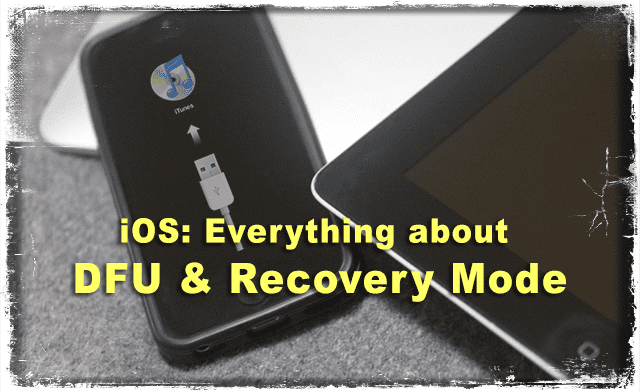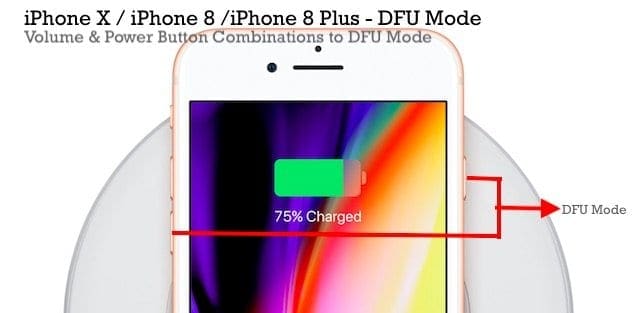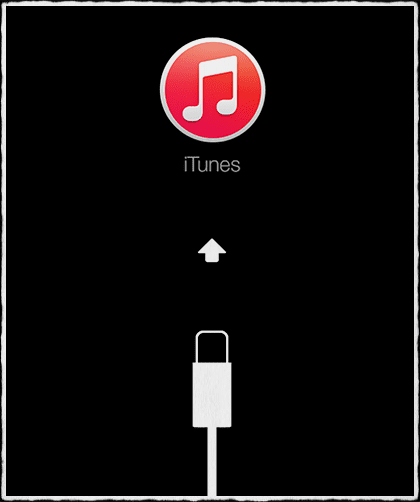Sometimes recovery mode just doesn’t do the trick and you need to go into DFU mode to reload your iOS. This often happens when a jailbreak goes wrong. iFolks are often confused about the difference between DFU and Recovery Mode. DFU stands for the Device Firmware Update, it’s that state of your iDevice when it doesn’t load the Operating system on itself but still interacts with iTunes. Hence, DFU Mode allows all devices to be restored from any state
DFU Mode is very different from Recovery mode because DFU bypasses the iBoot bootloader on your iPhone, iPod Touch and iPad.
This is the main difference between the Recovery mode and DFU mode. On the other hand, Recovery mode uses iBoot during restoring or upgrading your iPhone. In bypassing the iBoot bootloader, DFU Mode allows downgrades of your current firmware because there is no iBoot agent during the DFU mode.
The quickest way to know if you’re in DFU Mode is that your screen appears totally black in DFU mode. Not so with Recovery.
Contents
- 1 Uses of DFU Mode
- 2 Instructions on Performing a Forced Restart By Model
- 3 How To Enter DFU Mode on an iPhone X or iPhone 8
- 4 How-To Enter in DFU mode on iPad, iPods, and Earlier iPhone models
- 5 How to Exit from DFU Mode
- 6 Recovery Mode
- 7 How to Enter Recovery Mode
- 8 Similarities and Differences between DFU and Recovery Mode
- 9 Conclusion
Related Articles
Uses of DFU Mode
Apple doesn’t allow downgrading to previous versions of iOS; this is where DFU mode comes in handy. It allows you to downgrade to previous versions of iOS, to troubleshoot major issues, install custom firmware, or unlock your iPhone. iFolks also use it to jailbreak their iDevices.
For example: If you have installed iOS 10.2.1 on your iPhone and want to downgrade your iPhone to previous iOS versions to get the Jailbreak, you need to enter in DFU mode. However, device compatibility and downgrading software are also needed to install previous versions of iOS.
Before restoring
- Verify that you are using the latest version of iTunes
- Backup your device if possible
- Transfer and sync content to your computer if possible
If you own an iPhone 8, iPhone 8+ or iPhone X, please follow the steps below to enter the DFU mode on your device. For iPads, iPod Touches, and earlier model iPhones look further down for detailed instructions.
Instructions on Performing a Forced Restart By Model
- On an iPhone 6S or below plus all iPads & iPod Touches, press Home and Power at the same time until you see the Apple logo
- For iPhone 7 or iPhone 7 Plus: Press and hold both the Side and Volume Down buttons for at least 10 seconds, until you see the Apple logo
- On an iPhone X or iPhone 8 or iPhone 8 Plus: Press and quickly release the Volume Up button. Then press and quickly release the Volume Down button. Finally, press and hold the Side button until you see the Apple logo
How To Enter DFU Mode on an iPhone X or iPhone 8 
- Update to latest iTunes version on your computer FIRST
- Connect Your iPhone to your Computer using the Lightning Cable
- Launch iTunes and make sure that your iPhone shows up on the list of devices
- Make Sure your iPhone is switched ON
- Next, Press the Volume UP button followed immediately by the Volume DOWN button
- Now, Press and hold the Side or Power button until the iPhone screen turns black
- Your screen should stay black, if not go through the previous steps again
- Release the Side or Power button and press down both the Side or Power button AND Volume DOWN button together for 5 seconds
- After 5 seconds, release the side or power button but keep pressing the Volume Down button
- Give it a few seconds, around 10, till iTunes recognizes the DFU mode and check that your screen remains black
- If you successfully entered the DFU Mode on your device, you see a message that “iTunes has detected an iPhone in recovery mode. You must restore this iPhone before it can be used with iTunes.”
- If not, repeat these steps
If you do not see a black screen, you are not in DFU Mode. Please run through these steps again.
How-To Enter in DFU mode on iPad, iPods, and Earlier iPhone models
The most important thing before entering in DFU mode is the timing; you should hold the buttons for exact time as mentioned below. Otherwise, it leads to recovery mode instead of DFU mode.
Be aware that DFU mode is signified by having a completely black screen on the device. So if you don’t see anything, this is normal.
First, Turn OFF Your iDevice
- Open iTunes on your computer
- Connect your computer and your iDevice
- Hold the Power Button for 3 seconds
- Continue holding the power button and ADDITIONALLY hold the home button OR iPhone 7 models, hold the volume down button for 10 seconds
- The screen remains blank throughout. If you see the “Connect to iTunes” message, your iPhone is in recovery mode. Restart the process again from step 1.
- Release the power button while continuing to hold the home button or for iPhone 7 models, the volume down button, for 5 seconds
- Again, if your phone displays the “Plug into iTunes” screen, you’ve held down too long and need to restart
- If your device’s screen remains blank, a dialog appears in iTunes saying it’s “detected an iPhone in recovery mode. You must restore this iPhone before it can be used with iTunes”
- Follow the on-screen steps to Restore iPhone or another iDevice

Now, interaction is easy between your iDevice and iTunes. You may install new custom firmware, Jailbreaks or downgrades. If your iDevice shows another message other than
If your iDevice shows ANY OTHER messages, Apple logos, OR NO BLACK SCREEN, it indicates that your iDevice is not in DFU mode.
How to Exit from DFU Mode
Exiting from DFU mode is rather simple as compared to enter into it.
Carefully follow these steps
- While still connected to your PC, force restart on your device by pressing and holding home + power (iPhone 6S and lower, all iPads and iPod Touches,) press and hold power + volume down (iPhone 7,) or tap volume up + tap volume down + press and hold side button (iPhone X and 8) until the Apple Logo Appears on the screen of your iDevice
- Release the button(s) so that your iDevice disappears from iTunes
- Now, press the ON/OFF or SIDE button and your iDevice restarts normally
Recovery Mode
Unlike DFU mode, Recovery mode is pretty simple and it can be defined as the state in which iPhone loads the bootloader but not the OS. However, it still interacts with iTunes to install fresh firmware and restores.
Uses of Recovery Mode:
Recovery mode doesn’t allow you to downgrade previous versions of iOS. However, you can simply restore your iPhone, iPod Touch or iPad to current firmware or install the updates using the Recovery mode. On the other hand, Recovery mode may also be useful to Jailbreak your iPhone, iPod Touch or iPad.
How to Enter Recovery Mode
Entering Recovery mode is pretty easy and simplest process.
- Make sure that you’re using the latest version of iTunes
- If iTunes is already open, close it
- Connect your device to your computer and then open iTunes
- Now, perform a forced restart on your iDevice (follow instructions above)
- Don’t release the buttons when you see the Apple logo
- Keep holding both buttons until you see the recovery mode screen

- A message appears with options to Restore or Update. Choose Update
- iTunes tries to reinstall iOS without erasing your data
- Be patient while iTunes downloads the software for your device
- If your download takes more than 15 minutes and your device exits recovery mode, let the download finish. THEN repeat these steps
- If Update didn’t work, repeat these steps and select Restore
- You may lose data, especially if you have not backed up on iTunes or iCloud
After your iDevice completes its Update or Restore, set up your device following the on-screen instructions.
How to Exit from Recovery Mode
- While maintaining the connection between your iPhone or iDevice to your Mac or Windows PC, force restart your device following the instructions above to completely turn off your iPhone
- Now, press the ON/OFF or Side button again to turn off your iPhone
- The Connect to Tunes logo should disappear
- If this method doesn’t solve your problem, you need to restore the latest iOS version for your iDevice
Similarities and Differences between DFU and Recovery Mode
- Both modes can be used to restore the latest version of iOS on iPhone, iPod Touch, iPad and iPad mini
- DFU mode does NOT offer you to SAVE CONTENT before restoring
- Both modes are easily returnable using the same methods as explained above
- DFU mode is a necessary step for Jailbreaking iPhone, iPod Touch or iPad using Redsn0w as the Jailbreak Software While Recovery mode is necessary for installation of new firmware
- DFU mode can also be used to downgrade to previous versions of iOS but Recovery mode can’t
- Recovery mode doesn’t bypass the bootloader on iDevices while DFU mode can easily bypass the Bootloader and prevent loading the default OS on iDevice
Conclusion
Both the DFU and Recovery Mode are very useful to install custom firmware, update, unlock or Jailbreak iPhone, iPod Touch or iPad. Remember that you need to backup your data BEFORE a disaster occurs, not afterward. So make backing up a part of your iDevice daily or weekly routine.
Entering or exiting from DFU or recovery mode depends upon the timing of pressing the Sleep and Home Button. Pressing home button for too long may lead to recovery mode instead of DFU mode.